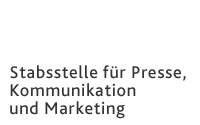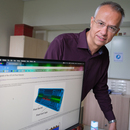Executive Department for
Press, Communication and Marketing
Adolf-Reichwein-Straße 2a Gebäude AVZ (Gebäudeteil AR-NA) 57068 Siegen
Phone: +49 (0)271/740-4915 Fax.: +49 (0)271/740-4911 E-Mail: presse@uni-siegen.de
Support for research on the ATLAS-Experiment increased
Siegen physicists continue their research at the particle accelerator (CERN) and are developing highly complex components for the pixel detector upgrade.
Physicists at the Center for Particle Physics Siegen at the University of Siegen are continuing their research at the world's largest particle accelerator, the Large Hadron Collider (LHC) at the CERN research center in Geneva. The Siegen team’s involvement in the ATLAS project has been extended and the support for two projects has been increased by the Federal Research Ministry to 2.3 million Euro. “This is a considerable increased support for us,” explains Prof. Dr. Markus Cristinziani, head of the Experimental Particle Physics working group at the University of Siegen. “This is a great success, which also creates possibilities for future scientists at our university.” Doctoral candidates and post-docs can perform research related to the most fundamental scientific questions of our time. Among other things, programming methods for machine learning are being employed. Siegen's physicists have already been part of the research network for many years, with over 3000 scientists from around the world who work on the ATLAS project.
The ATLAS project is one of the large-scale experiments at the Large Hadron Collider (LHC), in which key questions of elementary particle physics are examined. The particle accelerator, also called “World Machine”, is 27 kilometers long and 100 meters below the earth. ATLAS stands for A Toroidal LHC ApparatuS and it is the largest detector ever built for a particle accelerator. A machine as large as a house: 46 meters long, with a diameter of 25 meters. With over 100 million electronic channels, it detects particles that are created from collisions in the particle accelerator.
A broad spectrum of physical phenomena are being analyzed. The interest of the Siegen working group is foccused on the top quark, the heaviest elementary particle. “We are examining the interactions between the top quarks and the Higgs boson and other bosons,” explains Cristinziani. For the properties of elementary particles and their interactions are still not fully understood. “And so we are continuing to work on the question of whether the prediction according to the standard model of particle physics is correct or whether deviations will be measured as a result of experiments in the particle accelerator.” The recording and analysis of the giant quantity of data from the ATLAS detector are supported in a research network within the framework of the first project that receives funding.
A second funded project for Siegen' s physicists concerns the further development of the highly complex core of the ATLAS detector, the pixel detector. The particle accelerator is constantly being upgraded and operatesfurther at higher intensities. “The detectors have to be adapted for this”, explains Cristinziani. “We are working on the upgrade to the pixel detector.
A clean room is currently being constructed at the Emmy-Noether-Campus at the University of Siegen, in which highly complex electrical engineering components are being designed and built, which cannot be bought.
The pixel detector is the part that is located closest to the accelerator's interaction point. “It is sort of the microscope of the entire ATLAS detector,” stresses the Siegen physicist. When the particles collide, particle tracks are created, which are then measured. “And the closer we get to the collision points, the denser the particle tracks.” The pixel detector is able to resolve these. “This is a technology that has been developed in international cooperation between many research institutions,” emphasizes Cristinziani. As part of the new project, the scientists from Siegen will build and test around 200 new modules for the detector. The Federal Ministry for Education and Research provides the project funds to finance the design and development of the components.
Elementary particle physics in Siegen has a long tradition and is one of the profile areas at the University of Siegen. “We only recently appointed the two key professors in experimental and theoretical particle physics, so this tradition is being continued,” stresses Prof. Dr. Thomas Mannel, physicist and pro-rector for research and new scientific talent. “We are pleased that Siegen’s involvement in the ATLAS experiment is being extensively supported for the next three years by the BMBF, which impressively documents the high scientific quality of the Siegen contributions.


